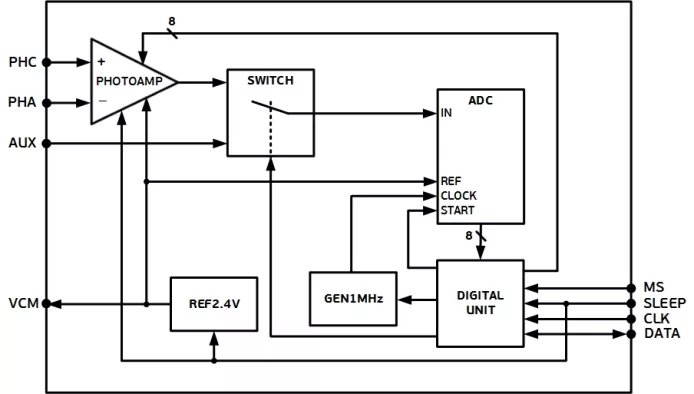TI-101 is an integrated circuit of XC06 HV technology. The main application of TI-101 is using in photoelectronic smoke detectors designed for fire identification based on the changes in the optical smoke density and the ambient temperature. This specific usage is provided by a photoamplifier, an ADC, a digital unit, a clock generator and a reference voltage source.
TI-101 operates in conjunction with a control microcontroller or an application-specified integrated circuit. The IC is controlled by a built-in digital unit.
Photoamplifier gain adjustment is available.
There can be selected the following operation modes of the device:
• measurement of smoke optical density mode;
• temperature measurement mode.
«SLEEP» input allows to switch the integrated circuit into the low consumption mode.
An analog-to-digital conversion of the output signal is performed by an 8-bit SAR ADC.
Integrated Photoamplifier with built-in ADC
Overview
Key Features
- Power supply range: 4.0-5.5 V
- 8-bit ADC
- Reference voltage source: 2.4 V
- 1MHz clock generator
- ESD-protection
Benefits
- Serial IC control interface
- Sleep function
- Temperature measurement extra input
- Photoamplifier gain adjustment via digital code
- Photoamplifier gain temperature compensation
Block Diagram

Applications
- Photoelectronic smoke detectors for fire identification based on the changes in the optical smoke density and the ambient temperature
Deliverables
- Datasheet
- GDSII database
- Customer support
Technical Specifications
Short description
Integrated Photoamplifier with built-in ADC
Vendor
Vendor Name
Foundry, Node
X-FAB XC06 HV (600 nm)
Maturity
Verified IP
Availability
Yes
Related IPs
- 24-bit Cap-less ADC 106 dB SNR with ASRC 6 channels
- 24-bit Cap-less ADC 106 dB SNR with ASRC and phase alignement 6 channels
- Ramping 12-bit ADC with Sequencer
- Analog Front End: 1 channel of 12-bit 2 GSPS ADC IQ Pairs, 1 channel of 12-bit 2 GSPS DAC IQ Pairs, PVT & Integrated PLL
- Crypto Coprocessor with integrated Post-Quantum Cryptography IPs
- ADC